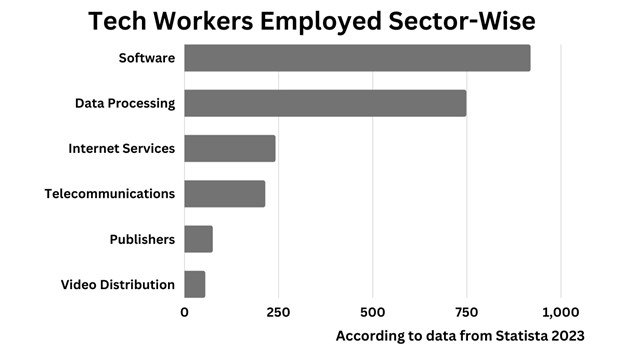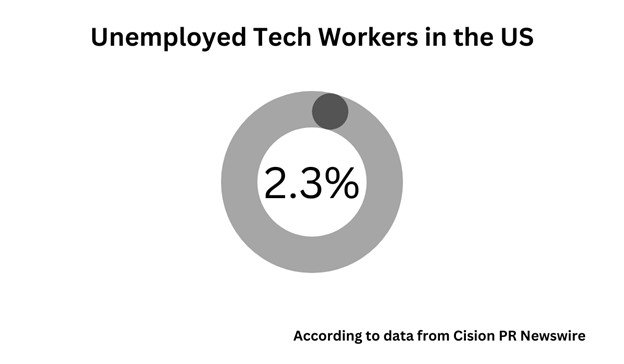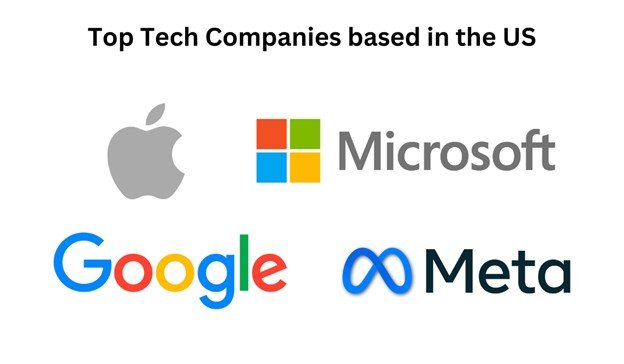The IT industry is a driving force behind the rapidly evolving digital landscape, revolutionizing how we work, communicate, and live. As technology continues to shape our world, understanding the IT sector‘s employment trends and statistics becomes paramount for professionals and organizations alike.
This article delves into the realm of IT industry employment statistics, shedding light on the current state of the industry, the demand for skilled talent, emerging job roles, and the transformative impact of technology on employment opportunities.
IT Industry Employment Statistics
Key Takeaways
- The number of job openings for tech positions is expected to increase in the upcoming years, owing to the digitalization of many industries.
- While new doors open, some are expected to close as Automation, AI, and robots replace labor-intensive jobs.
- Additionally, the US and Japan have the highest record for employment in the tech sector. Japan is unparalleled in innovation, and the US is home to the headquarters of the world’s top tech companies.
- Furthermore, remote work is favored among tech employees, provided their respective companies support them with adequate hardware and software.
- Companies with flexible work policies like hybrid and remote work have greater employee satisfaction rates as cloud-based technologies have revolutionized the concept of working from home.
- Lastly, the future of tech jobs is bright and promising as newer innovations require more brains and expertise.
Key Statistics
- In August 2022, 25,500 net new workers were hired in tech companies and startups in the US.
- The US Bureau of Labor Statistics (BLS) states that employment in the tech industry has increased by 175,700 jobs in 2022 and is 46% ahead of last year and 92% ahead of 2019.
- According to CompTIA, around 5.8% of the US workforce is working in the tech sector.
- In June 2022, the tech sector in Singapore employed 136,100 people while hiring an average of 8100 workers per year for the past 5 years.
- On December 7, 2022, Hitachi (Japan) announced they would hire 30,000 people with expertise in digital transformation over the next 3 years.
- Cision mentions that in 2022, the percentage of unemployed workers in the tech sector stood at 2.3%.
- According to TechBehemoths, in 2022, the US added 267,000 new jobs to the tech market.
- According to CompTIA, 272,323 new tech jobs will open up in the US in 2023.
- The Canadian government also allocates 2% of its GDP to IT services.
- Hitachi (Japan) intends to hire 98,000 people in digital transformation by March 2025. They set aside 500 billion yen ($3.69 billion) for further investments in tech.
- In a PwC survey around October 2018, 40-50% of employees preferred to work face-to-face.
- In one of their blog posts, Tech.Co states that from 2019 to 2021, the number of people working part-time had almost tripled from 5.7% to 17.9%
- Additionally, 47% of businesses observed increased productivity among employees working part-time.
- Furthermore, PwC states that 78% of CEOs believe remote collaboration is here to stay.
- According to Owl Labs, 16% of tech companies globally operate 100% remotely.
- Statista states that around 2020 to 2021, 48% of organizations had invested in cloud-enabled tools in order to support their remote workforce.
Current Percentage of Employed Workers
1. United States
The Cision distribution provided through PR Newswire enables communicators to discover and connect with influential individuals, create and disseminate impactful narratives, and assess the monetary outcomes of their endeavors.
One of their reports extensively quotes data from CompTIA about employment in the tech sector in 2022.
In August, 25,500 net new workers were hired in tech companies and startups.
The “Employment Situation” report by the US Bureau of Labour Statistics (BLS) states that employment in the tech industry has increased by 175,700 jobs in 2022 and is 46% ahead of last year and 92% ahead of 2019.
Furthermore, Zippa is a reliable online career platform that guides workers toward employment opportunities that suit their needs. One of their articles stated that in 2020, 12.2 million workers were employed in the tech sector.
According to CompTIA, around 5.8% of the workforce is in the tech sector.
2. Singapore
CNBC states that the Infocomm Media Development Authority (IMDA) has trained almost 15,000 Singaporean tech workers and has provided them with specialized roles. These tech jobs span multiple industries, for example, financial services, wholesale and retail trade, and education. Moreover, these employment opportunities also come with comprehensive on-site training and learning facilities to enhance and nurture employees’ skills.
CNA operates as a transmedia company, providing users with content accessible through various platforms, including online, TV, radio, and smart devices. In addition to delivering up-to-date news, CNA offers diverse content encompassing business, lifestyle, human stories, current affairs, and documentary programming to cater to its audience.
One of their articles states that in June 2022, the tech sector employed 136,100 people. Over the past 5 years (since June 2017), tech companies hired an average of 8100 resident employees each month.
3. Japan
Statista provides some figures on the employment percentages in the IT sector in the year 2020. They have provided a breakdown of tech workers in each industry, as represented by the figure below.
To provide more precise figures, the industrial statistics are as follows:
| Industry | Number of People in Thousands |
| Software | 918.2 |
| Data Processing and Information Services | 747.78 |
| Internet-related Services | 241.04 |
| Telecommunications | 213.86 |
| Publishers (except newspapers) | 74.53 |
| Video Picture Information Production and Distribution | 54.44 |
| Private Broadcasting | 42.99 |
| Newspaper Publishers | 39.2 |
| Services incidental to Video Picture, information, sound information, character information production, and distribution | 32.13 |
| Commercial Art and Graphic Design | 29.15 |
| Cable Television Broadcasting | 24.69 |
| Sound Information Production | 9.5 |
Nikkei Asia’s mission is to merge the rich voices and vibrant pulse of Asia’s economies through exceptional journalism and well-founded opinions. They also strive to be an indispensable asset as you pursue professional success in Asia, the thriving epicenter of global economic growth and innovation.
In one of their articles published on December 7, 2022, they state that Hitachi planned to hire 30,000 people with expertise in digital transformation over the course of the next 3 years. This announcement was made to defy the huge number of tech layoffs that resulted from Japan’s labor-saving innovations, such as robots.
Current Percentage of Unemployed Workers
An article on Statista published on March 31, 2023, states the number of people laid off worldwide from tech startups in 2020-2022.
In 2022, the number of employees laid off from tech startups in the retail sector was more than 20 thousand. Similarly, startups in the transportation, finance, and consumer sectors also had some of the highest layoffs.
1. United States
An article on Computer World uses recent data from the US Bureau of Labor Statistics (BLS) to demonstrate the unpredictability of job openings each month in 2023. Although a hefty 339,000 jobs were available in the market in May, the overall unemployment rate rose by 0.3%, reaching 3.7%. Amidst this, the number of unemployed people rose by 440,000, reaching nearly 6.1 million people (BLS).
CompTIA is a platform that provides analysis and job reports in the technology sector. It also provides its own analysis for unemployment in the tech job space based on data from the BLS. They state a decrease in employment from 2.1% to 2.0% in May.
The report on Cision mentioned previously quotes precisely that the percentage of unemployed workers in the tech category in 2022 stood at 2.3%.
2. Singapore
According to CNBC, since 2022, Singapore has also undergone many tech layoffs. An online marketplace, Carousell, reduced 10% of their headcount last December. Shopee, too, notified that they had started their third round of layoffs in November.
3. Japan
In an article by Nikkei Asia, they state that Japan’s labor-saving innovations and rapid advancements in the field of robotics will severely threaten their employment rate by 2025.
According to Al Jazeera, Japan had a considerable tech gap before it was filled by Ukranian evacuees who were entering year two of war.
Similarly, the IMF (International Monetary Fund) states that as Japan advances in robotics, its labor force is shrinking, thus meaning it expects further layoffs in the future.
Job availability
1. United States
An article by a reporter on Computer World states that tech jobs in the economy rose by 45,000. Its headline also claims that there are far more tech job openings than people to fill them. Thus, the US is a hub for job opportunities. They also quoted a figure from the US Bureau of Labor Statistics (BLS) stating 4,725 available jobs in May 2023.
TechBehemoths is a project that has facilitated connections between real projects and a network of 45,001 IT companies spanning 143 countries and 6,988 cities.
In one of their blog posts, they mention that the tech industry in the United States added 267,000 new jobs in 2022. They also state that the average annual salary of a software developer in the United States is around $105,000.
Some of the most renowned tech companies, such as Google, Microsoft, Meta, and Apple, were created here.
Based on data from around 2022, the article by Zippa mentioned previously states that the US tech industry makes up 35% of the total world market. They also added 264,500 new tech jobs to the market, with over 585,000 tech companies in the country.
CompTIA mentions that 272,323 new tech jobs will open up in the US tech market in 2023. Similarly, the projected growth rate for tech jobs over the next decade is twice the national job rate.
2. Switzerland
In accordance with Glassdoor Jobs, the average annual salary for IT in Switzerland is €103,886. It is home to many notable tech organizations, such as the Swiss Federal Institute of Technology (ETH Zurich) and the Paul Scherrer Institute, which is involved in extensive IT research.
3. Singapore
IT specialists in Singapore have an average salary range of €58230 per year.
In addition, the nation boasts a rapidly expanding technology sector, with significant investments being made in digital infrastructure and emerging technologies, including AI, cloud computing, and cybersecurity. Moreover, it serves as the headquarters for prominent tech enterprises like Grab, Lazada, and Sea Group.
According to CNBC, Singapore is investing heavily in its IT sector. Singapore Bank OCBC announced in 2022 that they planned to hire 1500 tech workers in the next 3 years.
Additionally, STLogistics revealed its plans to invest 1.7 million Singapore dollars ($1.2 million) in promoting the acquisition of digital skills, such as software robotics, among its employees.
Moreover, in 2022, 7 out of 10 vacancies in information and communication roles were new positions.
Thus, Singapore is rapidly resolving its unemployment issue through investments in its IT infrastructure, WiFi, and many other services.
4. Canada
When it comes to IT jobs in Canada, the average salary stands out as notably higher compared to other sectors, with a median annual income of approximately $73,193. As per the Canadian government’s projections, the IT industry is anticipated to witness an annual growth rate of 2.3% until 2026, creating approximately 216,000 new jobs. Furthermore, the government also allocates 2% of the country’s GDP (Gross Domestic Product) to IT services in order to further encourage its growth and expansion. According to the digital ranking 2022 report, Canada is among the top 10 countries owing to its impeccable IT infrastructure and services.
5. Japan
Japan has gained global recognition as a highly advanced nation in information technology. It also holds a distinguished reputation for its production of state-of-the-art technology. This includes innovative designs in mobile phones, televisions, gaming consoles, robots, etc.
The average annual income for an IT employee in Japan is around 51127.08 Eur.
Furthermore, it is the headquarters for many prosperous technology companies, including Sony, Panasonic, Fujitsu, Toshiba, Hitachi, and NEC.
Japan is at the forefront of industries such as robotics, Automation, and electronics, solidifying its position as a global leader. In the digital ranking report of 2022, Japan secured a position among the top 30 nations worldwide for digital competitiveness.
According to Nikkei Asia, one of Japan’s renowned tech companies, Hitachi, intends to raise hirings in the digital transformation sector. They aim to reach almost 98,000 hirings by March 2025. Furthermore, the company has already set aside 500 billion yen ($3.69 billion) for investments in the sector.
Analyzing the aforementioned country data shows that countries with the highest job availability have significant reasons behind this trend. Also, countries with impeccable IT infrastructure and record-breaking WiFi speed are the main hubs for IT job opportunities.
Full-time and Remote Work Statistics
Since 2020, many companies have adopted hybrid work strategies. This includes investments in hardware and other necessary equipment to support their IT workforce.
1. Full-Time Employment
According to an article published on Statista on October 27, 2022, a pre-pandemic estimate of the full-time workforce in the ICT sector was expected to reach 55.3 million. This was an increase of 3.9% from 2019.
PwC provides professional services across two segments: Trust Solutions and Consulting Solutions. Their capabilities also span cloud and digital solutions, deals advisory, ESG services, cybersecurity, governance, risk management, transformation, tax services, and more.
In one of their surveys based around October 2018, 40-50% of employees preferred to work face-to-face.
2. Remote Work
A report on Cision mentioned multiple times in the same article states that many tech organizations in the United States adopt the options for remote work. Between January and August 2022, tech job listings explicitly mentioning remote work increased by 56%. This is in comparison to the previous year and by 281% compared to the pre-pandemic year of 2019.
CodeMonk is a platform that provides tech industries with a pool of rich talent for recruitment. They published a list of statistics for tech industries in 2022 while referring to the linked sources.
According to Owl Labs, 16% of tech companies globally operate 100% remotely. The same study also mentions that around 62% of people work remotely. It is important to note that there are more who wish to adopt the remote work route in the future.
Furthermore, after healthcare (15%), the tech industry has the highest number of remote workers (10%).
Moreover, another article on Statista states that around 2020 to 2021, 48% of organizations had invested in cloud-enabled tools. This was in hopes of supporting their remote workforce. Similarly, 47% had spent on digital collaboration tools, so working from home while corresponding with team members ensued smoothly. Organizations that spent on other tools are demonstrated by the figure below.
3. Comparison between On-site vs. Remote Work
A forecast for the 2022 hybrid/remote workspace by Statista showed that 29% of the responders were already working in a hybrid model at various tech industries. 34% were sure they would be working remotely in around 6 months, whereas 36% planned to work remotely on a permanent basis.
Tech.Co is a community that discusses the latest trend in the tech workspace. One of their blog posts mentions that from 2019 to 2021, the number of people working part-time had almost tripled from 5.7% to 17.9%. This information was gathered from a press release by the Census Bureau. People working remotely increased from 9 million to around 27.6 million people. During this, 65% of employers wanted their staff back in the office.
According to a survey by Tech.Co, 47% of businesses had observed increased productivity among employees working part-time/remotely. Furthermore, 78% of CEOs believe that remote collaboration is here to stay. Employees working from home (89%) have a more positive approach toward work compared to those who work on-site (77%).
Top in-demand tech jobs today
The demand for IT professionals has increased drastically as the world continues to shift toward digitalization. This is especially true after the global pandemic in 2020 that prompted many businesses to operate online. Some industries that require such professionals include technology manufacturing, telecommunications and internet services, software publishing, and many others.
WhatIs is an IT-specific website by TechTarget that provides the latest insights on advancing tech, along with new keywords, quizzes, and articles to engage all sorts of readers. One of their articles, published on February 9, 2023, lists the most in-demand tech jobs in the world today as follows:
Breakdown
- Software Developers or Software Engineers: are responsible for building software programs, applications, networks, and operating systems. This also includes extensive documentation and software testing. Their median salary is around $109,020.
- Data Scientists: interpret and analyze huge data sets using technologies like machine learning (ML), AI, and predictive modeling. Their median salary is around $100,910.
- Artificial Intelligence Specialists: develop programs and machines that imitate the human mind. They do this using AI and ML technologies. Their median salary is around $125,494.
- IT Managers: are responsible for defining any organization’s short- and long-term IT goals. This includes collaborating with higher-ups and stakeholders to draft practical goals based on available resources. Additionally, their median salary is around $159,010.
- Information Security Analysts: are responsible for protecting computer systems and networks from malware and cyber-attacks. This also includes foresight on how to prevent future attacks. Their median salary is around $102,600.
- Computer Systems Analysts: design computer systems for multiple organizations. They study the business models of the client organizations and decide which technologies best suit their requirements. Their median salary is around $99,270.
- Computer Network Architects: design and construct client organizations’ communications and data storage networks. Their median salary is around $120,520.
- Site Reliability Engineers: ensure that applications and websites for business use operate smoothly. Their median salary is around $162,337.
- DevOps Engineers: are responsible for resolving development problems during a project lifecycle. They have knowledge of both coding and engineering systems in order to solve these issues. Lastly, their median salary is around $119,058.
Future of employment in the IT sector
As the world progresses with digitalization and now integrating augmented reality and AI into preceding technological systems, it is safe to say that the future of the IT sector is indeed bright.
An article on Financial Express states that companies are very likely to increase their budget for technological upgrades within their companies. IT spendings are to increase by 13% year over year in 2023, with an increase of 5% at the company level.
The future of IT offers new ways to amalgamate existing technologies with newer ones to create exciting new products. According to Intel, the future of IT brings many opportunities for professionals and businesses, provided they are taking the necessary steps to support this growth (IT infrastructure).
Some of the key technologies that will most likely prosper in the future are as follows:
- Artificial intelligence (AI) and Automation
- Internet of Things (IoT) and Edge Computing
- Cloud Infrastructure
- Information Security
- Cyber Security
FAQs
-
How much is the IT industry worth?
According to Statista, the global spending on IT in 2022 was around 5.3 trillion US dollars. The regions that contribute to this amount are Asia (31%), North America (35%), Latin America (6%), Africa (5%), and Europe (22%).
The Business Research Company states that the IT industry will amount to $11995.97 billion by 2027.
-
What are the world’s biggest tech companies?
According to search results on Google, some of the top tech companies in the world right now are as follows:
- Apple
- Microsoft
- Intel
- IBM
- Cisco Systems
- Alphabet
- Adobe
-
What are the top-paying industries for tech workers?
According to Thinkful, the industries that pay their IT specialists handsomely are:
- Transportation
- Education
- Communication
- Retail
- Technology
- Entertainment
- Healthcare
- Financial Services
-
What is the fastest-growing tech job in 2023?
According to Udacity, there are multiple tech jobs gaining popularity by the day. However, software development is at the top. This term encompasses entry-level programmers as well as machine learning engineers who code programs to be executed on various computer systems. The job growth rate for this position is 26%.
Conclusion
In conclusion, IT industry employment statistics reveal evolving trends and transformative forces. The number of employed people in the IT sector varies across regions based on infrastructure and budgetary allocations. Countries like the U.S. and Canada lead in IT infrastructure, resulting in higher employment rates. Moreover, automation and intelligent technologies shape the future of IT employment, streamlining processes but requiring skill-set shifts.
As routine tasks are automated, and the field of robotics becomes more popular, countries like Japan have started to lay off most of their workers. Nonetheless, the U.S. still provides numerous jobs home to some of the world’s largest companies’ headquarters.
Post-pandemic, employees have begun to prefer remote or hybrid work as many companies have started investing in cloud-enabled tools. Although the tech industry is a booming one, notable (and highly paid) IT professions include software engineers, data scientists, machine learning engineers, and cyber security specialists.
Ultimately, the world of IT industry employment is brimming with possibilities, offering both challenges and rewards for those who are ready to embrace the transformative power of technology and navigate the ever-changing landscape with confidence and adaptability.

















